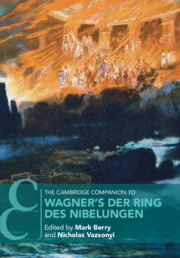Book contents
- The Cambridge Companion to Wagner’s Der Ring des Nibelungen
- Cambridge Companions to Music
- The Cambridge Companion to Wagner’s Der Ring des Nibelungen
- Copyright page
- Contents
- Figures
- Music Examples
- Contributors
- Preface
- Abbreviations
- Introduction
- Part I Myth
- Part II Aesthetics
- Part III Interpretations
- Part IV Impact
- 11 Critical Responses
- 12 Placing the Ring in Literary History
- 13 Specters of Nazism
- 14 The Ring in Cinematic and Popular Culture
- 15 Notable Productions
- Bibliography
- Index
11 - Critical Responses
from Part IV - Impact
Published online by Cambridge University Press: 18 September 2020
- The Cambridge Companion to Wagner’s Der Ring des Nibelungen
- Cambridge Companions to Music
- The Cambridge Companion to Wagner’s Der Ring des Nibelungen
- Copyright page
- Contents
- Figures
- Music Examples
- Contributors
- Preface
- Abbreviations
- Introduction
- Part I Myth
- Part II Aesthetics
- Part III Interpretations
- Part IV Impact
- 11 Critical Responses
- 12 Placing the Ring in Literary History
- 13 Specters of Nazism
- 14 The Ring in Cinematic and Popular Culture
- 15 Notable Productions
- Bibliography
- Index
Summary
In the years since its inception, Wagner’s Ring has generated significant commentary and controversy. Critics of the Ring asserted its influence in public discourse (beyond music criticism of the work and its performances) and generated ambitious intellectual and ideological debates about art, society, and politics. This chapter charts some milestones in these debates, including the contributions of well-known thinkers such as Nietzsche, Shaw, and Adorno, but also some of their French, German, or Russian contemporaries whose influence has waned since the fin de siècle. In the twentieth century, seminal musicological approaches emerged that transcend analytical-technical matters, such as Alfred Lorenz’s ideologically charged investigations of Wagnerian form or Richard Donington’s psychoanalytic explanations. More recently the task of interpreting the Ring has shifted from the written word to the operatic stage, where directors explore and expose its various and conflicting layers of meaning. Whether formulated by philosophers, writers, musicologists, or artists, two basic approaches emerge from these interpretations: They either develop a social or political interpretation from the Ring outward, or they insert the tetralogy into a preexisting worldview.
- Type
- Chapter
- Information
- The Cambridge Companion to Wagner's Der Ring des Nibelungen , pp. 247 - 268Publisher: Cambridge University PressPrint publication year: 2020

